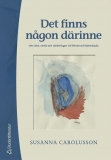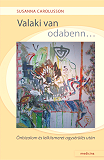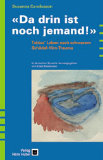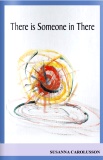|
|
|
Utbildning, kommande
Stresshantering inspelningar
Publications and Assignments
Curriculum vitae
Kontakta
Det finns nĺgon därinne
Beställ boken:
Mot faktura:
Skicka ett mejl till
susanna@carolusson.se,
uppge fakturadress
Pris 200:- inkl moms.
 Det
finns nĺgon därinne
Det
finns nĺgon därinne
Om vĺrd, värde, och värderingar vid förvärvad hjärnskada
Susanna Carolusson
Hur är det att förlora en vuxen son, som överlever till ett nytt och annorlunda liv med en svĺr skallskada?
Kan vĺrdpersonal, personliga assistenter och anhöriga lära sig att uppskatta det unika hos varje patient, brukare och familjemedlem?
Tobias rĺkade ut för en cykelolycka och blev hjärnskadad. Tobias mor, bokens författare, berättar pĺ ett personligt sätt om vĺrd, värde och värderingar med början i det akuta omhändertagandet, i de nära anhörigas reaktioner och i de plĺgsamma insikterna om förluster. Ur förtvivlan växer kraften att finna inspiration trots ovisshet. Läsaren fĺr följa Tobias process under drygt fyra ĺr efter traumat.
Författaren lyckas förmedla tvĺ perspektiv: Hur hon i sin öppna och sĺrbara modersroll blir lika lyhörd för sonens icke-verbala kommunikation som hon var under den tidiga spädbarnsperioden. Och hur denna känsliga modersfunktion mĺste avbrytas gĺng pĺ gĺng, för att växla till en utĺtriktad kamp mot omvärldens snäva perspektiv. Det andra perspektivet är ett professionellt reflekterande, där läsaren uppmanas att ta personlig ställning, utan att författaren erbjuder nĺgot facit, men ett förhĺllningssätt som avspeglar hennes lĺnga erfarenhet av professionell kommunikation och personalhandledning.
Denna bok fyller en lucka i vĺrd-, psykologi- och sociala utbildningsprogram, pĺ myndighets- och departementsnivĺ och som inspirationskälla i bĺde den professionella och privata kretsen runt en hjärnskadad person.
"Det finns nĺgon därinne" är nu även översatt till ungerska:
Valaki van odabenn
Carolusson, S. (2020) Valaki van odabenn. Medicina kiadó Zrt. Budapest.
ISBN 978 963 226 759 3
Köp: medicina förlag
 Valaki
van odabenn...
Valaki
van odabenn...
Önbizalom és lelkiismeret agysérülés után
Susanna Carolusson
Susanna Carolusson így kezdi a könyvét: „Ez a könyv egy teljesen egészséges 23 évesről szól, aki élethosszig rokkant lett”. Valójában azonban a könyve nemcsak a fiáról, Tobiasról szól, aki majdnem végzetes balesetet szenvedett, hanem Susannáról és a család többi tagjáról is. Egy pillanat műve, és nemcsak Tobias, hanem az egész család élete darabokra hullott. Ez a küzdelemről, örömről, bánatról és elszántságról szóló könyv. Egy olyan asszony írta, aki hirtelen az anya és a szakember kettős szerepében találja magát, és mindkettőben kihívások elé néz.
Az agysérült személyek rehabilitációjában néhány dolog különösen jelentős. Így a sérülés helye és kiterjedtsége, a sérült eredeti személyisége, az, hogy a családtagjai hogyan viszonyulnak a sérüléshez, és milyen az attitűdjük azzal kapcsolatban. Tudományosan igazolt, hogy a sérült viselkedése befolyásolja az életminőségét, és a család pozitív viszonyulása szintén hat a gyógyulás szintjére.
A türelem és a változás Susanna könyvének központi témái. A könyvben bemutatott kihívások a változtatható és a változtathatatlan dolgokról szólnak. És vajon ki tudja, hogy mi lehetséges?
Néha rendkívül felszabadító megtalálni azt a fajta erőt, ami sosem hagyja magát elnyomni, aminek köszönhetően sosem adjuk fel, és ami mindig jelen van érzelmileg a tragédiáknál. Éppen ezek azok a megoldások és az eltökéltség, amit Susanna könyve bemutat, még ha a sikerek aprók és lassan jelennek is meg.
ISBN: 978-3-456-83960-8
In deutscher Sprache herausgegeben von Edda Klessmann. Aus dem Schwedischen übersetzt von Inger Hille. 2003. 198 S., mit zahlreichen Abb., darunter 13 farbige, Kt
 Da
drin ist noch jemand!
Da
drin ist noch jemand!
Tobias' Leben nach schwerem Schädel-Hirn-Trauma
Susanna Carolusson
Dies ist die ergreifende Geschichte eines jungen Mannes, der ein schweres Schädel-Hirn-Trauma erleidet. Dank der fachlichen Kompetenz und dem persönlichen Engagement seiner engsten Umgebung gelingt es, ihn in die Welt zurückzuholen, für die er fast schon verloren war.
Dies ist die Geschichte eines jungen Mannes, der mit 23 Jahren bei einem Fahrradunfall ein schweres Schädel-Hirn-Trauma erlitten hat. Die Autorin, seine Mutter, begleitet mit ihrer enormen Energie und ihrer Hellhörigkeit für oft kaum wahrnehmbare Äußerungen den Genesungsprozess und unterstützt diesen - dank eigener erprobter Fachkompetenz - aktiv. Vor allem hat sie den Mut aufgebracht, das, was in den Jahren der Rehabilitation geschehen ist, bis in zum Teil intimste Details sehr anschaulich und verständlich zu berichten. Dabei geht es primär gewiss um die "menschliche" Seite, aber auch um die fachliche: Die intensive Suche nach Verständnisbrücken zu einem Menschen, der zwar, in der ersten Zeit nach dem Unfall, am Leben ist, aber kaum noch Reaktionen zeigt, könnte beispielhaft sein für den Einsatz bisher ungenutzter Möglichkeiten der Verständigung mit schwer geschädigten Menschen. Dieses ergreifende Dokument einer "geduldig-beharrlichen, zwischen Hoffnung und Verzweiflung pendelnden Gratwanderung" (Edda Klessmann) beweist einmal mehr, wie fachliche Kompetenz gepaart mit persönlichem Engagement buchstäblich Wunder wirken kann.
Published in English: (2010)
Alom Editores SA de CV,
México, 2009.
You can
read the book
On line!
Order the paperback book:
www.litenupplaga.se
(for Sweden)
www.bokus.se
(for Sweden)
www.adlibris.se
(for Nordic Countries)
You can by the book here!
(for other than the Nordic Countries)
 There is Someone in There.
There is Someone in There.
confidence and conscience in caring after brain injury
By Susanna Carolusson
![]() Reviews
There is Someone in There
Reviews
There is Someone in There
Foreword
By Peter Währborg, Senior Physician and Associate Professor at Sahlgrenska University Hospital, lic psychol, lic psychother.
Susanna Carolusson begins her book with the words, "This is a book about a perfectly healthy 23 year old who acquires a lifelong disability." In reality, however, her book is not only about her son, Tobias, the person who has suffered a nearly fatal accident, but also about Susanna and the rest of her family. In an instant, not only Tobias’ life, but the lives of his entire family are ripped to shreds. This is a book about struggle, joy, sorrow and desperation. It is written by a woman who suddenly finds herself simultaneously in the role of both mother and professional, and both are put to the test.
I have worked with brain damaged individuals, both young and old, for almost 20 years. One of the most important things I have learned is that the kind of injury that happened to Tobias affects the entire family and the entire network of which s/he is a part. Neither the changes in the injured person’s immediate world nor the situation in which s/he finds him or herself can be described in strictly medical terms. But Susanna shares these with us in a personal, intimate way.
It takes courage to do this. Susanna has an unusual, and at times, almost brutal passion for justice. No feelings or situations come up without her reviewing them critically. It is exactly this confrontational expression of her integrity that makes her story so gripping. She gives us a story about a terrible tragedy and makes it possible for us to begin to understand something so painful that it is almost impossible to comprehend. At the same time, her story helps give us the courage to try to act effectively in similarly difficult situations.
This book is also a book about a search for meaning. The search for meaning is typical of both the brain damaged individual himself and of the family members who are trying to come to terms with the effect of that injury on their own lives. Sometimes this search is akin to groping in the dark, but sometimes it is crowned with the kind of success that ultimately manifests itself in faith, hope and love.
Some factors are especially meaningful for the rehabilitation of brain damaged individuals. These include the location and extent of the brain injury, the injured person’s previous personality, and his or her family members’ understanding of the injury and their attitude towards it. There is clear scientific evidence that the injured person’s attitude affects both the quality of life and his or her level of functioning. A positive attitude on the part of his family members also makes a difference in the degree of recovery.
It is not possible to do much about the location and extent of the injury or about the personality of the injured person, but attitudes are subject to change. A good silent prayer in such a situation is the one that says, ...Grant me the serenity to accept the things I cannot change and the courage to change the things I can...
Patience and change are the central themes of Susanna’s book. The challenges described in the book lie in the possibilities and impossibilities of change. And who really knows what is possible?
Sometimes it is enormously liberating to meet the kind of strength that never lets itself be repressed, that never gives up, and that is always emotionally present in the face of a tragedy. And that is the kind of resolve and determination that are demonstrated by Susanna, and that she is able to turn into successes, even if those successes are small and slow to develop.
Introduction
This is a book about a perfectly healthy 23 year old who acquires a lifelong disability. It is about the greatest fear parents have concerning their children, that their child will be the victim of an accident and will be deprived of their ability to think, move, speak or do anything we associate with the ability to live a full life.
I am the author, as well as the mother of this book’s main character. Sometimes I appear to be the main character myself, since this account is told from my perspective and influenced by my own personal feelings. In spite of this and with the distance that comes from time, I have come to realize that my feelings should be left uncensored, partly because they accurately represent the reactions of family members, and partly because, looking back, I can see that these feelings gave me the strength to act in the interest of my son. I also feel my reactions were in touch with reality. This goes against most crisis theories that teach that denial and being out of touch with reality are the normal reactions to be expected in a crisis.
I have described separate happenings and reflections which took place during a long and significantly more complicated process than I am able to do justice to on paper. Instead of simply reading a detailed story, the reader is invited to consider his or her own reactions to a series of events which make up an endless chain of events. The book stretches over a time period starting with the accident and reaching up to a little more than four years later.
The process began with a tragedy; a bicycle accident which took my son Tobias’ life -- or at least the life which he led up to that moment in time. I’d like the reader to get a glimpse of how complicated such a process can be, in its desperation, sorrow, hope, and in its spiritual impact. I’d also hope to convey a sense of the meaning and significance of these events and of the power of love in dealing with them on a daily basis.
I am writing from the perspective of both a mother and psychologist, simply because I am both. My identity as a psychologist is so much a part of my personality that I can never remove myself from this perspective. I found that this was appreciated by many of the health care workers who helped our family, but it was appreciated most by Tobias. Unfortunately, my combined roll as a mother and psychologist was, to my great chagrin, perceived by some health care professionals as problematic. I was sometimes met with the attitude that I should have left my profession at the door and simply acted like any another family member.
This book is meant for family members and loved ones, hospital and rehabilitation professionals and caretakers, as well as for former patients who have lost physical and/or mental abilities. I hope to inspire family members and friends to participate in the care of their loved ones and to pay attention to their own feelings, with the confidence that it is their innate right to do so. I also hope to inspire neurologists and other health care professionals who work in emergency rooms, as well as in rehabilitation and daily care facilities, to see how much more can be given, without necessarily taking more time or costing more money. This book is also written for patients who have come far enough in their own process of rehabilitation that they have the strength to hear a story which reminds them of their own. The reader should know, however, that this is a story which does not avoid that which is difficult and that which I believe must be suffered through by all those who wish to continue their journey of personal maturation. Perhaps I can help one of these former patients find the strength to share with others how it really feels to have lost abilities others take for granted.
During the period this book is written, there were many people who contributed important and even crucial input to my son’s rehabilitation. I am aware that I have left out numerous such contributions and I hope that those people I have not mentioned still feel proud about their role in helping Tobias. There will also be those who will recognize themselves as being criticized. These readers are welcome to contact me if they wish to turn my criticism into an opportunity to discuss our different perspectives. It is not, in any case, my intention to make anyone feel like a failure. I believe that everyone intended to do his or her best for Tobias, so I hope that those who feel that I have been critical of them will ponder alternative ways of approaching similar situations and think about how they would want other people to act if they found themselves in a situation similar to ours.
I also want to thank Tobias and the other brave people whose stories are told in this book for letting me publish intimate details, especially since I know that this type of detail is experienced by many as extremely private, too much so to ”air in public”. The question of where one should draw the line between that which is personal, but can be shared, and that which is so intimate that its knowledge should stay inside the circle of family and close friends, is a subjective one. Tobias will be happy if he, with all of his social limitations, can still contribute to others by letting his uneven existence be described and read about. He will also be happy if he has the opportunity to inspire and influence others. That will strengthen his confidence and give his life more meaning. I also hope and believe that the book’s intimate examples will inspire its readers to open themselves for the written and unwritten questions which are raised by this story and which demand their own answers.
I have added discussion questions for those readers who use this book in their studies or continuing education. I do not provide answers, nor do I wish to give the impression that there are any easy solutions in some of these difficult situations. Instead, the purpose of these discussion questions is to invite you to reflect upon and recognize yourself and your own role in the process of caring for individuals in situations like my son’s. It is also my hope to contribute to your own professional growth by sharing the perspective that has come from my intimate involvement in the story I have told. Professional growth is a developmental process that every professional must undergo, using their own personal experiences, ideals and values both as a starting point and as a foundation. Solutions, as well as answers to general questions on health care issues, can of course be found in research literature whose main intent is to communicate facts. This book, however, is dedicated to the emotional and practical significance of facing day-to-day reality in the kind of difficult situation I have described. The competencies explored here are more of the sort that express themselves in personal reflections and in emotional responses and personal values -- in interest, honesty, tact, compassion, clarity and the ability to set limits. On one hand, these are qualities that can be cultivated and developed, but in all practical terms, they vary from one relationship to another. In achieving what is usually called “psychological assimilation” universal knowledge emerges only from specific, concrete situations. It is for this reason that I repeatedly use an inquiry based teaching technique based on questions which I hope will encourage reflection and critical thinking.
The book can be used in both study groups and professional work groups. I recommend that the questions be discussed under the leadership of a psychologist or counselor who has experience leading discussions focusing on large and small questions surrounding such existential questions such as the meaning of life and the nature of professional treatment relationships.
Those close to me who have read the manuscript, including Bertil Rydenhag, the author of the appendix, have said that the book ”stands alone”, even without the discussion questions. In other words, the book not only lends itself to those uses noted above, but should also appeal to anyone who is interested in life’s surprises and the effects a physical and psychological trauma can have on a family.
Back cover of the Swedish publication
How is it to lose an adult
son, who survives into a new, different life, with a serious brain
damage?
Can health personnel, counselors and relatives learn to appreciate the
unique character in each patient, disabled and family member?
Tobias was severely brain damaged in a bicycle accident. His mother, the author, informs in a personal way about health care, values and attitudes, from intensive care, family crisis reactions, and the growing awareness of excruciating loss. Despair is turned into the power to find inspiration despite uncertainty. The reader is invited to follow Tobias thrilling existence during four years after the accident.
The author
manages to convey two perspectives: How she in her receptive and
vulnerable role as a mother develops an extraordinary sensitivity to her
son’s nonverbal communication, as between mother and infant. And how
this empathetic maternal function repeatedly gets interrupted, when she
has to resist or conquer narrow-minded authoritarian institutions. The
other perspective is from her professional competence, encouraging the
reader to take a personal stand in delicate but everyday queries. She
doesn’t give the answers, but her approach reflects her long experience
of professional communication and counseling. It becomes especially
creative when she combines her maternal receptivity with her
professional skill in her hypnotic communication with Tobias.
This book is a long asked for inspiration, that fills a gap in
educational programs, on governmental and departmental level and as a
source of inspiration for the professionals as well as the private
circle around a brain damaged person.
Lic. psychologist, lic psychotherapist, MSc. Susanna Carolusson works since the beginning of 1980 as a clinical psychologist, psychotherapist and supervisor with clinical treatment and hypnosis. She is an often invited expert and lecturer at the Gothenburg University, consultant for the Sahlgrenska University Hospital and an often invited speaker at international congresses on hypnosis and psychosomatic medicine. She is also a frequent teacher, consultant and counselor for rehabilitation personnel, more so, since the book was published in Swedish.
With its existential approach, this book touches and concerns anybody, not only those who have to deal with brain damaged people at work, at home or in social contexts, but everyone who is prepared to enjoy the miracles of passion and persistence.
Market analysis and reviews
The Swedish publisher
Studentlitteratur doesn’t know of any book in the english language, but
for one Australian exception, which gives a solid and deep insight in
the rehabilitation process after a brain damage, from a family
perspective.
The publisher of the German translation, Huber Verlag in Bern, doesn’t
know of any book which teaches the importance of a psychotherapeutic
approach with the brain damaged patient, from such a deep dynamic
perspective.
According to dr Edda Klessman, Lemgo, Germany, who has initiated the
translation in German, investigated how the book was received in the
biggest neurological rehabilitation center in North Germany. She says
that the treatment of PTSD has advanced recently in many areas, but has
been underestimated in the rehabilitation of brain trauma, because of
the tendency to explain all symptoms as neurological in origin. The
staff regards the book as adding psychotherapeutic competence to
neurology and neuropsychology. This is also the opinion of a reviewer,
Klaus Krippner, Witten, Germany: “Another book on PTSD, could have been
superfluous, where it not for this one. The author succeeds to balance
the professional and the personal experiences. Her simple language, the
personal but never awkward emotional openness, and her ability to
distance herself, makes the book an exciting reading and vitally
important for everyone who deals with somatic and psychological trauma.”
(Buchbesprechung. Imagination, nr 1/2004)
The Swedish Library Service website (www.btj.se) announced: “….students
and seniors in basic and advanced education in health and care programs
will benefit from this book. Anyone with interest in existence and
survival will be inspired and with admiration take part of this family’s
experiences.” (Marguerite Bjellvi).
After having searched for
equivalent books I come to the conclusion that this book adds something
unique: The emotional reactions of the victim of an accident are
analyzed not only from a neurological and cognitive perspective, but
from a deep understanding of psychological crisis and trauma, which is
often neglected in the care of brain traumatized people.
Books written by a family member have a tendency to be so subjective,
that professionals don’t feel that they have anything to learn but some
more sympathy. Professional books on the other hand, are often distant,
objectively objectifying, describing cognitive and neurological
consequences of brain trauma, but they miss integrating the healing
power of compassion, respect, integrity and love, into their
perspectives. This book has both perspectives; the passionate
inspiration and the professional soberness.
In this book, professional sound knowledge of existential dynamic
psychology and the expertise of hypnosis is combined with maternal
sensitivity and persistence. From readers and reviewers I have the
impression that this is a unique book.
S.C.
